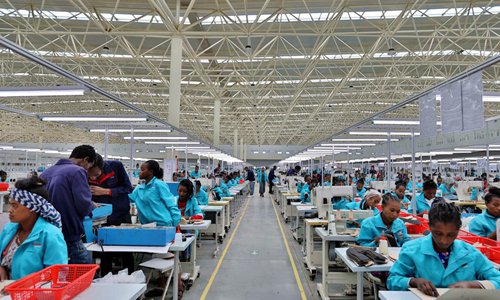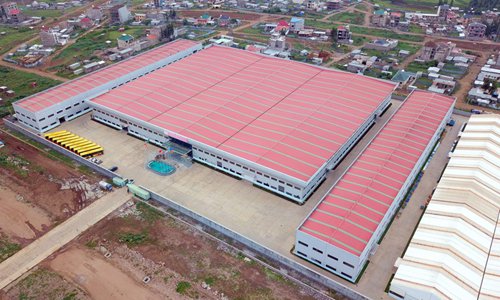HOME >> CHINA
Chinese-built industrial parks help boost Ethiopian exports
Source:Xinhua Published: 2019/8/10 8:53:34

Shoemakers work on the production line at Huajian Light Industry City in Addis Ababa, Ethiopia, June 12, 2019. (Xinhua/Wang Teng)

Built on 138 hectares of land, the Huajian Light Industry City in Addis Ababa, Ethiopia will create up to 60,000 jobs when completed by 2020, according to the Chinese company Huajian. (Xinhua/Wang Teng)
Ethiopia has earned 142 million U.S. dollars in export value from Chinese-built industrial parks, an Ethiopian official said on Thursday.
Hana Arayaselassie, Deputy Ethiopia Investment Commissioner, said 142 million U.S. dollars in export value was earned during the Ethiopian fiscal Year 2018/19, which ended on July 7, reported state media outlet Ethiopia News Agency (ENA).
Arayaselassie, said the construction and commissioning of the Chinese-built Ethiopia-Djibouti electrified rail line in January 2018 has contributed to boosting landlocked Ethiopia's export ambitions, by transporting speedily and efficiently cargo from industrial parks in mainland Ethiopia to ports in Djibouti.
She said that "142 million U.S. dollars of export value was earned from Chinese-built industrial parks. This is 50 percent higher than during the same period in the 2017/18 fiscal year."
Ethiopia is constructing or has commissioned around 12 industrial parks across the country, part of a broad economic strategy to make the country a light manufacturing hub in Africa by 2025.
Nine of the industrial parks are located in proximity to the 756 km Ethiopia-Djibouti electrified rail line, which since being commissioned in January 2018 has been hailed for boosting landlocked Ethiopia's foreign trade.
Contracted by two Chinese companies, the first 320 km of the rail project from Sebeta to Mieso was carried out by the China Rail Engineering Corporation, while the remaining 436 km from Mieso to Djibouti port section was built by the China Civil Engineering Construction Corporation.
With Ethiopia attracting large-scale investment in the export-oriented manufacturing sector, especially from Chinese firms, the country sees improving the efficiency and speed of the logistics sector as key to meeting national manufacturing revenue goals.
Posted in: DIPLOMACY,CHINA FOCUS